Costs are rising. Higher home prices are not the result only of high demand, but they also reflect the increasing cost of land, labor, materials, technology and government regulation. It’s a given that the home you buy today — even if it’s the same size and quality, with the same features — will be more expensive, sometimes substantially more, than the home you might have bought last year.

On the flip side, if you opt to spend the amount that you budgeted last year, those dollars today are likely to buy you a smaller, perhaps simpler, home, with fewer custom features than you might wish.
It’s a reality. There is a problem, but a wealth of new ideas promise innovative new solutions.
Solving the Dilemma
A recent article in Builder Online by John McManus, award-winning editorial and digital content director at Hanley Wood in Washington, DC, started us thinking. He discussed site-built homes versus modular construction and he offered a recipe for good home building, stating that “The secret again is optimizing instead of compromising; therefore, finding every way possible to improve building quality while also reducing cost.”
Following his lead, we devised our own formula to maximize buyer appeal and ensure reasonable profit for builders and contractors:
Technology + Building Efficiency + Skilled Labor + Standardized Customization = Home building Success
While it may seem obvious, the path to success requires constant adjustment; little is “set in stone.”
Take Technology
There was a time not too long ago when home builders clung to familiar ways of doing things on the job site, while embracing new computer software in the office. Architects made the jump from hand-drawn blueprints to CAD plans, but job superintendents continued to mark up those plans manually to reflect on-the job changes. SKU-based pricing for estimating and ordering may have brought new efficiencies, but site control of materials usually reverted to hand counting. There are numerous other examples.
The job site itself can become more efficient, according to thoughtful planners. Technology has introduced incredible new innovations to the way homes are built — from utilization of manufactured components to wireless communication, instantaneous transmission of documents between home office and job site, even GPS-based timekeeping and remote job site labor control. Monitoring and management techniques, BIM processes, digital technology and automated inventory controls — these and other efficiencies will streamline the process and compress the timeline of construction.
Skilled Labor
We have no doubt that a skilled, well-trained and educated work force will continue to be the mainstay of the home building industry. However, that in no way precludes the use of some types of modular construction and manufactured components that can add value as well as efficiency, reduce costs and save time to the home building process.
Builders and contractors must, however, seek new ways to attract and train new workers, compensate them fairly, offer opportunity for skills development and advancement, and assure future growth.
Although most homes are still built similarly to the way homes were built 50 years ago, that is not likely to be true for the future. Builders must be open to new techniques. There is perhaps no more important task facing the the construction industry today.
Standardization and customization
At Aterra, we believe that one of the most exciting aspects of the new “formula” is that standardization and customization are no longer mutually exclusive. Just as technology has introduced innovation and efficiency flows in both directions, new capabilities in terms of customization and upgrades are totally within the realm of the production builder.
By coordinating building efficiencies to integrate efforts across the building trades, home builders benefit from an enhanced ability to meet specific buyer desires. Buyers with special wants and needs are no longer limited to working with higher-priced custom builders.
In terms of lighting and electrical design we demonstrate that “standardized customization” offers value — to builders, buyers and contractors. There is no reason why it cannot be translated into a new paradigm for other trades. It only requires creative thinking and a commitment to develop problem-solving strategies.
We think that’s the way all innovation comes about: Working together to make the future brighter, better and more cost-effective so that everyone benefits.


